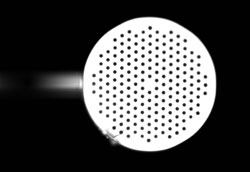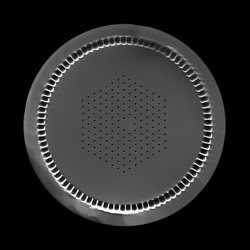Jacob Riis Folkenberg and Jes Broeng, Crystal Fibre A/S
Photonic crystal fibers, sometimes called microstructured fibers, represent a novel class of specialty fibers that began to see commercial application only within the past couple of years. They differ from conventional designs in that they incorporate a number of airholes, arranged in a well-controlled geometry, that run along the length of the fiber. The high and very accurate index contrast that may be realized in the cross section is unique to this class of optical fibers and has proved useful in several high-power applications.
The generic design consists of a hexagonal pattern of airholes in a pure silica matrix, with one or more holes “missing” to form the core. Because the refractive index of the cross section is constant — either n = 1 in the airholes or n ≈1.45 in the pure silica — the optical properties are controlled solely by the size and spacing of the airholes (Figure 1).

Figure 1. This basic photonic crystal fiber structure is single-mode at any wavelength with a constant-mode field diameter.
One benefit of this design is that single-mode guidance of light is possible with much larger effective mode areas than in conventional fiber (typically a factor of 10 or more). This is particularly advantageous for diffraction-limited high-power transmission, where nonlinear effects should be avoided.
Another basic fiber structure of note has a pure silica core region surrounded by a cladding region of airholes with very thin beams of glass in between. This forms a multimode fiber that may have a very large numerical aperture (typically >0.7) because of the high index contrast between the core and cladding. The numerical aperture, which is roughly a factor of two higher than what may be realized in conventional fiber, allows coupling light of a certain brightness into a core area four times smaller than that of standard multimode fiber.
For active double-cladding fiber, the combination of the two designs is particularly advantageous at high output powers (Figure 2). Compared with standard double-cladding designs, fiber manufacturers may reduce the pump guide diameter significantly because of the high numerical aperture, and/or increase the core size, yielding much higher pump absorption because of a larger overlap with the core dopants.

Figure 2. One effective fiber design combines the benefits of the generic photonic crystal fiber structure in Figure 1 and those of a fiber structure with a pure silica core region surrounded by a cladding region of airholes with very thin beams of glass in between. As a result, the length of fiber required to absorb the pump light is very short (on the order of a few meters), which greatly improves the stability of the laser and increases the threshold for nonlinear effects.
Experimentally, scientists have demonstrated high-efficiency 260-W CW output from 4 m of double-cladding fiber based on the photonic crystal design with a 250-mm2 mode area.1 In addition, high conversion efficiency has been realized with four- and six-times-larger mode areas.2 So far, pump sources have set the power limit. For more intense sources, the limit will be set by the ability to cool the fiber rather than by the onset of nonlinear effects.
It should be noted that, compared with a solid glass fiber, the thermal conductivity from the pump guide to the fiber surface is decreased only marginally by the air cladding. On the other hand, the single-material design of the air cladding is advantageous in terms of high-power handling compared with polymer clad fibers, for example, that may degrade over time. Typical pump guide background losses are well below 10 dB/km, which is similar to other types of double-clad fibers.
High-power fiber lasers based on photonic crystal fiber designs are finding many new applications in areas such as materials processing, typography and marking, thanks to their compactness and high beam quality. Any of the conventional rare-earth ions may be incorporated; however, ytterbium doping is a frequent choice because of the high conversion efficiency. Furthermore, the double-cladding design of photonic crystal fiber may be combined with Bragg gratings to select the desired operational wavelength.
The handling of photonic crystal fiber and conventional fiber is similar in terms of buffer stripping and cleaving. For high-power applications, the fiber ends are usually connectorized and sealed so that the airholes are not directly exposed to the environment, because any contaminants in the airholes may degrade the high-power performance.
References
1. J. Limpert et al (2003). Thermo-optical properties of air-clad photonic crystal fiber lasers in high power operation. OPT. EXPRESS, Vol. 11, pp. 2982-2990.
2. A. Liem et al (2004). Fiber lasers: technology, systems, and applications. Proc. SPIE, Vol. 5335, ed. Durvasula, pp. 158-169.
Meet the authors
Jacob Riis Folkenberg and Jes Broeng are researchers with Crystal Fibre in Birkerød, Denmark; e-mail: [email protected].